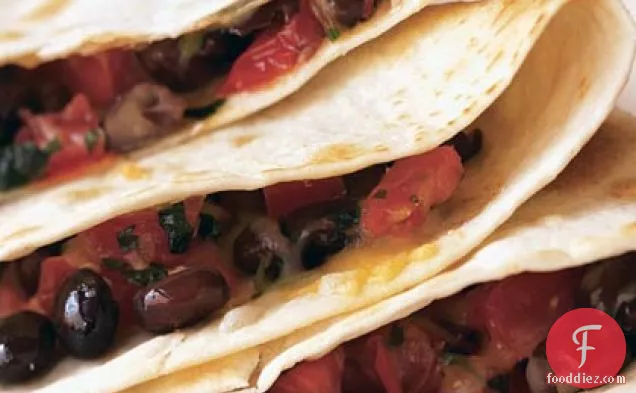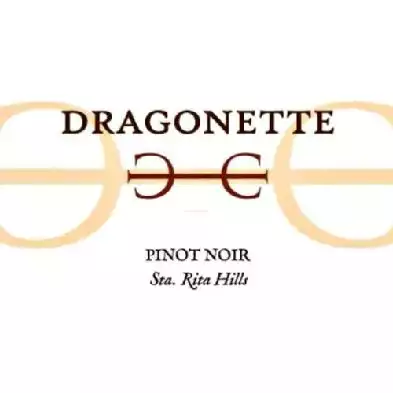Black Bean Quesadillas with Corn Salsa

Black Bean Quesadillas with Corn Salsa requires around 45 minutes from start to finish. This recipe covers 22% of your daily requirements of vitamins and minerals. This hor d'oeuvre has 411 calories, 17g of protein, and 14g of fat per serving. This recipe serves 4. This recipe is typical of Mexican cuisine. If you have cilantro, bottled garlic, lime juice, and a few other ingredients on hand, you can make it. To use up the flour tortillas you could follow this main course with the Cinnamon Sugar Crisps as a dessert.
Instructions
2
Heat olive oil in a large skillet over medium-high heat.
Ingredients you will need![Olive Oil]() Olive Oil
Olive Oil
Equipment you will use![Frying Pan]() Frying Pan
Frying Pan
4
Add tomatoes, 1/2 cup cilantro, and beans; cook 5 minutes or until liquid evaporates, stirring occasionally.
Ingredients you will need![Cilantro]() Cilantro
Cilantro![Tomato]() Tomato
Tomato![Beans]() Beans
Beans
5
Place tortillas on a baking sheet coated with cooking spray. Top each tortilla with 1/2 cup bean mixture and 3 tablespoons cheese; fold in half. Lightly coat tops with cooking spray. Broil 3 minutes or until cheese melts and tortillas begin to brown.
Ingredients you will need![Cooking Spray]() Cooking Spray
Cooking Spray![Tortilla]() Tortilla
Tortilla![Cheese]() Cheese
Cheese
Equipment you will use![Baking Sheet]() Baking Sheet
Baking Sheet
Ingredients
1teaspoons![bottled minced garlic]() bottled minced garlic2teaspoons
bottled minced garlic2teaspoons![bottled minced garlic]() bottled minced garlic425grams
bottled minced garlic425grams![black beans, drained and rinsed]() black beans, drained and rinsed237milliliters
black beans, drained and rinsed237milliliters![frozen whole-kernel corn]() frozen whole-kernel corn48-inchs
frozen whole-kernel corn48-inchs![(8-inch) flour tortillas]() (8-inch) flour tortillas118milliliters
(8-inch) flour tortillas118milliliters![chopped fresh cilantro]() chopped fresh cilantro2Tbsps
chopped fresh cilantro2Tbsps![fresh lime juice]() fresh lime juice1Tbsp
fresh lime juice1Tbsp![olive oil]() olive oil473milliliters
olive oil473milliliters![chopped plum tomatoes]() chopped plum tomatoes1
chopped plum tomatoes1![red bell pepper, chopped]() red bell pepper, chopped85grams
red bell pepper, chopped85grams![3/4 cup preshredded Mexican blend cheese]() 3/4 cup preshredded Mexican blend cheese
3/4 cup preshredded Mexican blend cheese
 bottled minced garlic2teaspoons
bottled minced garlic2teaspoons bottled minced garlic425grams
bottled minced garlic425grams black beans, drained and rinsed237milliliters
black beans, drained and rinsed237milliliters frozen whole-kernel corn48-inchs
frozen whole-kernel corn48-inchs (8-inch) flour tortillas118milliliters
(8-inch) flour tortillas118milliliters chopped fresh cilantro2Tbsps
chopped fresh cilantro2Tbsps fresh lime juice1Tbsp
fresh lime juice1Tbsp olive oil473milliliters
olive oil473milliliters chopped plum tomatoes1
chopped plum tomatoes1 red bell pepper, chopped85grams
red bell pepper, chopped85grams 3/4 cup preshredded Mexican blend cheese
3/4 cup preshredded Mexican blend cheeseRecommended wine: Pinot Noir, Riesling, Sparkling Rose
Pinot Noir, Riesling, and Sparkling rosé are my top picks for Mexican. Acidic white wines like riesling or low-tannin reds like pinot noir can work well with Mexican dishes. Sparkling rosé is a safe pairing too. One wine you could try is Dragonette Cellars Sta. Rita Hills Pinot Noir. It has 4.8 out of 5 stars and a bottle costs about 45 dollars.

Dragonette Cellars Sta. Rita Hills Pinot Noir
2016 was another in a string of terrific vintages in Santa Barbara. We had another early budbreak, and (unlike 2015) perfect weather during set, allowing for a strong, balanced crop. May, June and July were quite warm and ripening was fairly quick; however, an unseasonably cool August slowed the vines considerably. For the winemaker it was almost ideal, as the grapes were able to complete ripening slowly, without heat spikes, and the grapes maintained excellent acidity. Over a series of cool mornings, we picked each block at near perfect ripeness and balance. The wines appear to have great fruit character, fresh acidity and tannic structure and solid depth.DifficultyHard
Ready In45 m.
Servings4
Health Score35
Magazine

Your Inner Chef with Taylor Swift's Top 3 Recipes from Her Beloved NYC Hangout

20 Mouthwatering Recipes You Need to Try Today!

Master the Art of Making Perfect Pancakes with This Foolproof Recipe

The Science Behind Red Wine: Its Surprising Health Benefits and Potential Risks

12 Wine Cocktails for a Sophisticated Twist

Sip, Swirl, and Celebrate: Toasting to National Wine Day on May 25th

National Drink Wine Day on February 18

Celebrating Souffle Day with Delectable Delights

Indulge in the Delightful Flavor of Oyster Soup on Its Special Day!

Celebrating World Nutella Day

15 Easy Recipes for Students

14 Special Occasion Food Ideas

15 Mediterranean Diet Breakfast Recipes in 10 Minutes

How to Cook Fish without messing it up: A Beginner's Guide

American Classics You Can Easily Make at Home

How to Bake Muffins

Olives - the tiny briny fruit as the star ingredient

Comfort Food at Its Finest: The Best Beef Stew Recipes

Cooking with Beer: 5 Best Party Recipes

How to cook Beef and Steak

Your Inner Chef with Taylor Swift's Top 3 Recipes from Her Beloved NYC Hangout

20 Mouthwatering Recipes You Need to Try Today!

Sip, Swirl, and Celebrate: Toasting to National Wine Day on May 25th

National Drink Wine Day on February 18

Indulge in the Delightful Flavor of Oyster Soup on Its Special Day!

These Super Recipes for Your Football Party!

The Secrets Behind 3 Classic Comfort Food Recipes

Celebrate National Pizza Day on February 9th with Mouthwatering Slices and Fun Facts

Recipes to Spice Up Your February Menu




